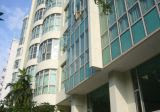NEW YORK: Rising bank stocks propelled indexes to their biggest one-day gain in six weeks Monday after influential banking analyst Meredith Whitney raised her rating on Goldman Sachs Group Inc. The bank reports earnings on Tuesday.
Whitney said also on CNBC that hard-hit Bank of America Corp. looks inexpensive given the assets on its books.
Her upbeat, albeit still cautious, tone on banks helped lift the Dow Jones industrial average 185 points in relatively thin trading volume.
It was the best performance for the blue chips since June 1 and follows a month of often directionless trading in which investors looked for any fresh sign that the economy was improving, not simply licking its wounds.
Traders saw good news in banks as a sign other industries could be in better shape than analysts had estimated. Hundreds of earnings reports from the April-June quarter are due this week.
Goldman has long been considered the strongest bank amid the economic downturn, but Bank of America has been one of the hardest hit by loan losses.
Any improvement in banks' profits could shore up their financial position and free money for lending.
Investors latched on to Whitney's comments because she has for years offered one of the more pessimistic - and accurate - assessments of the banking business.
While she remains cautious about the industry over all, the shift in tone gave the market a jolt.
Beyond Goldman, Bank of America, JPMorgan Chase & Co., and Citigroup Inc. are all scheduled to report second-quarter results this week.
Banks have taken some of the biggest blows among U.S. companies since the recession began in late 2007 as investment and loan losses mounted.
"There is a contingency of traders out there that believe the market can't recover without financials," said Randy Frederick, director of trading and derivatives at Charles Schwab.
Earnings reports will give investors a chance to see whether there was any meaningful economic improvement during the second quarter, and so far expectations are relatively low.
Stocks rallied in the spring amid hope of a recovery in late 2009, but the market has struggled since mid-June as more investors began to doubt that assessment.
The Dow rose 185.16, or 2.3 percent, to 8,331.68.
The Standard & Poor's 500 index jumped 21.92, or 2.5 percent, to 901.05, its first finish over the 900 mark since July 1. It was the S&P's best day since June 1.
The Nasdaq composite index rose 37.18, or 2.1 percent, to 1,793.21 and also posted its best performance since the start of June.
The Russell 2000 index of smaller companies rose 12.33, or 2.6 percent, to 493.31.
Three stocks rose for every one that fell on the New York Stock Exchange, where volume came to 1.2 billion shares compared with 922 million Friday.
The market's moves can be skewed when fewer shares are changing hands.
Among financial stocks, Goldman rose $7.57, or 5.3 percent, to $149.44 and Bank of America rose $1.11, or 9.3 percent, to $12.99.
The KBW Bank Index, which tracks 24 of the nation's largest banks, rose 6.5 percent.
The short-term buy call on Goldman from Whitney comes after the stock has risen 72 percent this year, but investors appeared to be looking past the fact that it had already had such a big advance.
"You're going to have people who were originally second-guessing what to do and not wanting to miss an opportunity to get in," said James Barnes, fixed income manager at National Penn Investors Trust Co., referring to bank stocks.
Many analysts had been expecting the company would turn in strong profits for the second quarter.
Goldman last month repaid the $10 billion it received last fall as part of the government's $700 billion bank bailout program.
Some financial stocks were still struggling, however.
Commercial finance lender CIT Group Inc. said it is talking with regulators about ways to improve its short-term liquidity as recent losses may jeopardize its compliance with capital requirements.
Treasury Secretary Timothy Geithner said Monday from London that he was confident the government has the authority and the ability to address the crisis at CIT.
The stock fell 18 cents, or 11.8 percent, to $1.35.
Earnings reports are expected from major companies in a range of industries this week, including Dow industrials components Johnson & Johnson, International Business Machines Corp. and General Electric Co. and technology bellwethers Intel Corp. and Google Inc.
"People are focused on sectors battered the most to see if there is any bounce-back," said Dan Deighan, founder of Deighan Financial Advisors in Melbourne, Florida.
Financial firms and retail companies will probably be the most closely watched industry as earnings are released, he said.
Data coming out this week also will offer insight into the economy. Investors will get readings on inflation, retail sales, industrial production and housing starts.
Last week, stocks fell for a fourth straight week and the Dow dropped to 8,147, its lowest level since April 28.
Since mid-June, investors have been giving back some of the 40-percent gains picked up during a vigorous rally that began in March.
Concerns have been mounting that the rally was overdone and investors are now waiting for fresh signs the economy is actually improving instead of just weakening at a slower pace.
The gains in stocks cooled demand for the safety of government debt, hurting prices and lifting yields.
The yield on the benchmark 10-year Treasury note jumped to 3.36 percent from 3.30 percent late Friday.

























